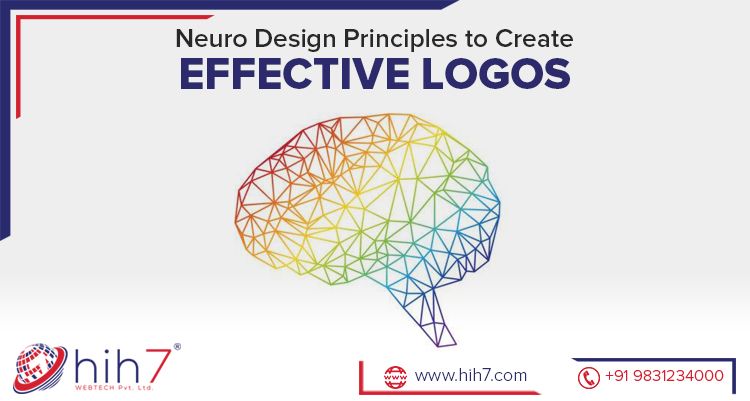Where on one side, marketers are relying on branding and design agency to create an effective business trademark, on the other side, logo designers are finding their success through a set of design principles and inspiration, for decades. Be it a designer or an endeavoring business owner, it is imperative to look for unique thoughts and concepts to create unique consequences. Such a unique concept can be figured out by embracing insights from neuroscience and psychology, thus guiding them to take more strategic design decisions. This is known as
neuro design. Neuro designs offer a set of fundamentals that allow the creator to decide how to design logos that will certainly be an appealing one and simultaneously can be more easily recognizable. As a result, neuro design can augment the logo design process of a
custom logo design company simply by using its principles to test designs against our brain reactions. Excited to know about the principles? View the following for details.
1.Visual Saliency:
Our brains are highly accustomed to recognizing visual elements that stand out from the surroundings. Such a quality is defined as a visual saliency by the neuroscientists. Is your logo incorporated with patterns? Update it before it hurts you. The best way to upgrade a logo's visual saliency is by improving the use of color, brightness, contrast, patterns, and depth. Embracing these properties at the initial stage of logo creation may yield a stand out effect. For example, the trademarks that use contrasting colors are easy to recognize as well as easy to memorize the visual elements. Likewise, the logo that has a depth feature, say suppose the Dropbox and PlayStation logos, will be a stand-out beyond any queries. Besides, there is another way to reach out to the audience – by implementing motion into logo designs. This can be incorporated using animation. For instance, iRobot uses an animated logo on its website, thus making it more captivating to the users. Ask your logo designers, whether they are using any such approaches for your business emblem.
2. Processing Fluency:
It will never be something hard to understand that our brain is biased towards logos that are easy to understand. Since it takes a lot of energy to process the data it consumes, our brain prefers to favor designs that are easy to decode. Neuroscientists term this method as processing fluency. Now, do you get why most of the brands are having simple but professional logos for their business? Some of the best examples can be Apple, McDonald's, and Nike. These graphical emblems are fluent and can be easy to process, easy to consume, and yes, of course, easy to memorize.
3. Propositional Density:
Embracing the last point, doesn't mean you implement something that is too simple. In extreme cases, too much simplicity can also be boring and unappreciated by the audience. You can't take any risk, right? To avoid such vulnerabilities is to introduce a rich interpretation. Neuroscientists call this propositional density. The density can be measured by taking a logo's number of deep elements divided by the number of graphical elements. If the result turns out to be greater than one, it means the logo has a good propositional density. So make sure you design a logo that holds a high density. You may take the logo of Apple for instance.
4. Discovering Patterns:
Alike color shades, our brains also have an intuitive bias towards patterns. According to the neuroscience, our human brain is more curious and always have a tendency to seek out new information. There are multiple ways to introduce patterns into a
logo design – geometric pattern or grid design, symmetry, and regular proportions or golden ration. Patterns may not be a mandatory requirement as they are often hidden. But it can be the easiest way to construct your logo design. For example the Twitter logo. Its iconic bird is formed by using overlapping circles.
5. Left visual field:
There is no strong compulsion that you need to keep your image on the left and text on the right. But in most of the cases, those designs are more aesthetically pleasing. The reason that neuroscientists deciphered is our mind is more bias to the left visual field that the right one. And so it is the first one to be delivered to the visual cortex. So does it make any sense, why you need to incorporate your icon or graphical element on the left side and wordmark or business name on the right side of the image? Consult with your custom logo design company for all such requisites.
6. Curves and Cusps:
We all have a tendency to prefer curves or tapered shapes instead of angular or spiky structures. Agree or not? The reason is quite insane. Sharp edges or angular sides in Perpetuum remind us of objects that hurt. Whereas a curve signifies smoother and is unusual to exist. Like the Apple logo, featuring your logo design with both curves and cusps can make your design more approachable. According to the research, it is found that when our human brain sees a logo, its visual elements are the first one to be processed in different parts of the visual cortex, at different times. The process is initialized by color, followed by form and motion. At last, the meaning of the logo is deciphered by our brain. Therefore, learning neuro design and embracing them has turned out to be the most convincing. Make sure your custom logo design company reckon this, for your productive future. Have you sorted out which one to choose to accomplish your requisite?
Graphic design contests, freelancers or agencies? I guess a perfect custom logo design company can be an ideal station. So prepared to have an effective engaging logo for your organization? Hih7 Webtech and its professional designers may serve you the same.
